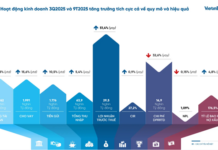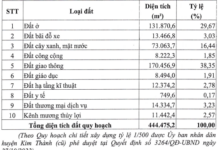A proposal was made during the conference held on August 8 to consult ministries, sectors, and northern provinces and cities on the draft Law amending and supplementing a number of articles of the Land Law.
At the conference, Ms. Trinh Thi Thu Huyen, Deputy Director of the Lao Cai Department of Agriculture and Environment, shared her opinion on land use planning and management. She suggested that the land use planning at the communal level should be abolished, and only the five-year land use plan at the communal level should be implemented. This suggestion is based on the practical difficulties faced in the past, where many cases had to be adjusted immediately after the completion of the planning process.
 Ms. Trinh Thi Thu Huyen, Deputy Director of the Lao Cai Department of Agriculture and Environment
|
According to Ms. Huyen, land use planning at the communal level should be combined with the formulation of a five-year land use plan, instead of being separated. This combined process should be carried out in a five-year cycle as very few land use plans remain unchanged over a ten-year period. Even at the district, provincial, and national levels, plans are typically reviewed and adjusted after five years. A five-year plan sufficiently reflects the targets and land use indicators for that period. When adjustments are needed, the process will be simpler, focusing only on indicator control.
Ms. Huyen provided an example: “This year’s target is to allocate 100 hectares of residential land, but the specific location will be decided by the competent authority. Alternatively, for 100 hectares of land with changed purposes, the local authority will proactively manage its arrangement and utilization. This delegation of authority provides flexibility, especially when there are new investment projects or investors outside the budget. Currently, if there is a new project and the land use plan is not suitable, adjustments will be challenging.”
“Although the plan targets for this year at the communal level are not high, adjustments are still needed in the planning process and related planning. According to regulations, in places with new construction or adjustments, the procedures will be simpler compared to adjusting existing land use plans,” she added.
Mr. Le Minh Ngan, Deputy Minister of Agriculture and Environment, acknowledged Ms. Huyen’s opinion and shared that this content had been discussed by the Central Executive Committee before. Resolution 18 clearly states that land use planning and management must be established from the central to the grassroots level. However, the conference will collect opinions from 15 northern provinces on establishing only a land use plan at the communal level, without a land use planning framework.”
According to the voting results at the conference, 12 out of 15 provinces agreed with the proposal to abolish land use planning at the communal level. These provinces included Hanoi, Ninh Binh, Tuyen Quang, Lang Son, Quang Ninh, Bac Ninh, Cao Bang, Lao Cai, Lai Chau, Hai Phong, Son La, and Thai Nguyen. The three provinces with different opinions were Phu Tho (disagreeing), Hung Yen (no opinion), and Dien Bien (absent).
As the only locality agreeing with the proposal to establish land use planning at the communal level, Mr. Phan Trong Tan, Vice Chairman of Phu Tho People’s Committee, shared his perspective. He believed that land use planning at the communal level is still necessary.
“Previously, land use planning and management at the district level were often done annually, but now it has been shifted to the communal level and extended to a five-year period, which is reasonable. However, it needs to be accompanied by a flexible adjustment mechanism. Within a year, many programs and projects may arise unexpectedly, and we cannot foresee them all. Therefore, timely adjustments should be allowed, and even multiple adjustments if necessary, to align with the practical situation,” Mr. Tan explained.
|
Article 66 of the draft amended Land Law proposes a 10-year land use planning period and a five-year land use plan period at the communal level. Additionally, it allows localities that have already developed plans in accordance with the law on urban and rural planning to forgo land use planning at the communal level. Instead, they can directly develop land use plans at the communal level based on the approved planning, land use indicators, and local demands. In cases where only a part of the planning has been completed according to the law on urban and rural planning, when developing land use planning at the communal level, the direction specified in the commune’s general planning for the land use planning period must be updated. |
Phan Thien – Thanh Huyen
– 6:17 PM, August 8, 2025
Proposed Land Revocation for Businesses Unable to Reach an Agreement with Locals
According to experts, the proposed policy of the State supporting the acquisition of the remaining 25% of land area needed for clearance once an enterprise has negotiated with landowners to obtain 75% consent, is a positive step towards unblocking stalled projects. However, the “75% threshold” should be flexible during the land acquisition process to prevent social backlash or inhumane evictions.
Local Government Bi-Level Organization: Are Land Price Tables Subject to Change?
According to the Land Administration Agency, the rearrangement of administrative units and the development of a model for a two-tier local government structure only involve changes in the nomenclature of administrative boundaries, with no alteration to the location or position of any land parcel.
“Striking a Balance: Revising Land Valuation Tables for Sustainable Revenue and Community Wellbeing”
It is imperative that the land price lists published by local authorities are realistic and avoid being overly optimistic or pessimistic. Overvaluation can deter businesses, while undervaluation can lead to a significant loss in revenue for the government. A balanced and accurate assessment is crucial to fostering a healthy business environment and ensuring a stable financial outlook for the region.
The Government Sets Primary Land Prices: A Step in the Right Direction
The government’s intervention in setting primary land prices is a strategic move to curb market volatility.













































